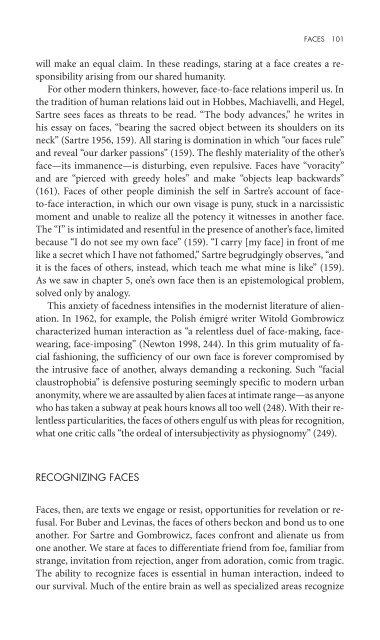Staring how we look sobre la mirada.pdf - artecolonial
Staring how we look sobre la mirada.pdf - artecolonial
Staring how we look sobre la mirada.pdf - artecolonial
You also want an ePaper? Increase the reach of your titles
YUMPU automatically turns print PDFs into web optimized ePapers that Google loves.
46 WHAT IS STARING?<br />
notes, “disrupt the smooth-running social order that normals righteously<br />
demand” (1997, 200). The ocu<strong>la</strong>r intrusion of people who cannot achieve<br />
inconspicuousness is itself an occasion for discrimination. The visually indiscreet<br />
ignite the uncomfortable partnership of staring. To be a stareable<br />
sight is unseemly, then, in part because it outs the starer for inappropriate<br />
<strong>look</strong>ing. To use Sartre’s shame model of <strong>look</strong>ing, staring as stigma assignment<br />
doubly shames starees—both for their supposed f<strong>la</strong>ws and for exposing<br />
their starers. <strong>Staring</strong>, then, can be a matter of <strong>look</strong>ing wrong and wrong<br />
<strong>look</strong>ing for everyone in the encounter.<br />
We make the unexpected out of what <strong>we</strong> have learned to expect, out<br />
of understandings of the world that come to us and that <strong>we</strong> remake. For<br />
instance, the concept of “tribal affiliations” illustrates <strong>how</strong> received culture<br />
structures expectations. The more commonalities <strong>we</strong> share, the more salient<br />
minor differences seem. This patterning of allegiances and exclusions is the<br />
root of nationalism and ethnicity, according to Michael Ignatieff (1997).<br />
Developing Freud’s notion of “the narcissism of minor differences,” Ignatieff<br />
asserts that <strong>we</strong> sort variations in behaviors, values, and corporeal traits<br />
into essential cultural difference <strong>we</strong> call ethnicity (48). Nationalism is the<br />
narcissistic overvaluing of differences rather than commonalities, a distortion<br />
that defines those different from us as outsiders, and an occasion for<br />
conflict. In another example, what <strong>we</strong> take to be gender, sexual, racial, and<br />
ability differences are <strong>la</strong>rgely minor but receive great social significance.<br />
Human variation matters when some characteristics merit privilege and<br />
others are sources of stigma. 20<br />
Human variation, in other words, is seldom neutral. “Abominations of<br />
the body” are in the eye of the <strong>we</strong>ll-acculturated beholder. Modern culture’s<br />
erasure of mortality and its harbinger, bodily vulnerability, make disabled<br />
bodies seem extraordinary rather than ordinary, abnormal instead<br />
of mundane—even though in fact the changes in our function and form<br />
that <strong>we</strong> think of as disabilities are the common effects of living and are<br />
fundamental to the human condition. What Goffman describes as “abominations”<br />
come to most ordinary lives eventually. If <strong>we</strong> live long enough, <strong>we</strong><br />
will all become disabled. 21


